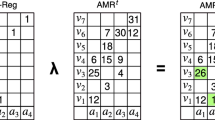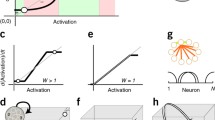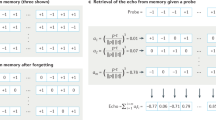Abstract
An approach to episodic associative memory is presented, which has several desirable properties as a human memory model. The design is based on topological feature map representation of data. An ordinary feature map is a classifier, mapping an input vector onto a topologically meaningful location on the map. A trace feature map, in addition, creates a memory trace on that location. The traces can be stored episodically in a single presentation, and retrieved with a partial cue. Nearby traces overlap, which results in plausible memory interference behavior. Performance degrades gracefully as the memory is overloaded. More recent traces are easier to recall as are traces that are unique in the memory.
Similar content being viewed by others
References
Ackley DH, Hinton GE, Sejnowski TJ (1985) A learning algorithm for Boltzmann machines. Cogn Sci 9:147–169
Anderson JA (1972) A simple neural network generating an interactive memory. Math Biosci 14:197–220
Anderson JA (1986) Cognitive capabilities of a parallel system. In: Bienenstock E, Soulie FF, Weisbuch G (eds) Disordered systems and biological organization. Springer, Berlin Heidelberg New York, pp 209–226
Anderson JA, Silverstein JW, Ritz SA, Jones RS (1977) Distinctive features, categorical perception and probability learning: some applications of a neural model. Psych Rev 84:413–451
Baddeley AD (1976) The psychology of memory. Basic Books, New York
Baddeley AD (1982) Amnesia: a minimal model and an interpretation. In: Cermak LS (ed) Memory and amnesia. Lawrence Erlbaum, Hillsdale
Ballard DH (1986) Cortical connections and parallel processing: structure and function. Behav Brain Sci 9:67–120
Barlow HB (1972) Single units and sensation: a neuron doctrine for perceptual psychology? Perception 1:371–394
Bower GH (1974) Selective facilitation and interference in retention of prose. J Educ Psych 66:1–8
Cooper LN (1973) A possible organization of animal memory and learning. In: Lundquist B, Lundquist S (eds) Proceedings of the Nobel symposium on collective properties of physical systems. Academic Press, New York, pp 252–264
Feldman JA, Ballard DH (1982) Connectionist models and their properties. Cogn Sci 6:205–254
Grossberg S (1983) Studies of mind and brain: neural principles of learning, perception, development, cognition and motor control. Boston studies in the philosophy of science, vol 70. Reidel, Dordrecht, Holland Boston
Halgren E (1984) Human hippocampal and amygdala recording and stimulation: evidence for a neural model of recent memory. In: Butters N, Squire L (eds) The neuropsychology of memory. Guilford, New York, pp 165–182
Halgren E (to be published) Physiological integration of the declarative memory system. In: Delacour J (ed) Neurobiology of memory
Hinton GE, Anderson JA (eds) (1981) Parallel Models of Associative Memory. Lawrence Erlbaum, Hillsdale
Hinton GE, McClelland JL, Rumelhart DE (1986) Distributed representations. In: Rumelhart DE, McClelland JL (eds) Parallel distributed processing: explorations in the microstructure of cognition, vol 1: Foundations. MIT Press, Cambridge, Mass, pp 77–109
Hinton GE, Sejnowski TJ, Ackley DH (1984) Boltzmann machines: constraint satisfaction networks than learn. Technical Report CMU-CS-84-119, Computer Science Department, Carnegie Mellon University
Hopfield JJ (1982) Neural networks and physical systems with emergent collective computational abilities. In: Proceedings of the National Academy of Sciences USA, pp 2554–2558
Hopfield JJ (1984) Neurons with graded response have collective computational properties like those of two-state neurons. In: Proceedings of the National Academy of Sciences USA, pp 3088–3092
Kanerva P (1988) Sparse distributed memory. MIT Press, Cambridge, Mass
Knapp AG, Anderson JA (1984) Theory of categorization based on distributed memory storage. J Exp Psych: Learning, Memory Cogn 10:616–637
Knudsen EI, du Lac S, Esterly SD (1987) Computational maps in the brain. In: Cowan WM, Shooter EM, Stevens CF, Thompson RF, (eds) Ann Rev Neurosci. Annual Reviews, Palo Alto, Calif, pp 41–65
Kohonen T (1972) Correlation matrix memories. IEEE Trans Comput C-21:353–359
Kohonen T (1977) Associative memory — a system-theoretical approach. Springer, Berlin Heidelberg New York
Kohonen T (1982a) Analysis of a simple self-organizing process. Biol Cybern 44:135–140
Kohonen T (1982b) Self-organized formation of topologically correct feature maps. Biol Cybern 43:59–69
Kohonen T (1984) Self-organization and associative memory. Springer, Berlin Heidelberg New York
Kohonen T (1990) The self-organizing map. Proc IEEE 78:1464–1480
Kohonen T, Mäkisara K, Saramäki T (1984) Phonotopic maps — insightful representation of phonological features for speech recognition. In: Proceedings of the 6th International Conference on Pattern Recognition. IEEE Computer Society Press, pp 182–185
Kohonen T, Mäkisara K (1986) Representation of sensory information in self-organizing feature maps. In: Denker J (ed) AIP Conference Proceedings 151. American Institute of Physics, New York, pp 271–276
Konishi M (1986) Centrally synthesized maps of sensory space. Trends Neurosci 9:163–168
Little WA, Shaw GL (1975) A statistical theory of short and long term memory. Behav Biol 14:115–133
Loftus EF (1975) Leading questions and the eyewitness report. Cogn Psych 7:560–572
Loftus EF, Miller DG, Burns (1978) Semantic integration of verbal information into a visual memory. J Exp Psych: Hum Learn Memory 4:19–31
McClelland JL, Rumelhart DE (1968) A distributed model of human learning and memory. In: McClelland JL, Rumelhart DE (eds) Parallel distributed processing: explorations in the microstructure of cognition, vol 2: Psychological and biological models. MIT Press, Cambridge, Mass, pp 170–215
Miikkulainen R (1990a) DISCERN: a distributed artificial neural network model of script processing and memory. PhD thesis, Computer Science Department, University of California, Los Angeles
Miikkulainen R (1990b) A distributed feature map model of the lexicon. In: Proceedings of the Twelfth Annual Cognitive Science Society Conference. Lawrence Erlbaum, Hillsdale, pp 447–454
Miikkulainen R (1990c) Script recognition with hierarchical feature maps. Conn Sci 2:83–101
Miikkulainen R (1991) Self-organizing process based on lateral inhibition and synaptic resource redistribution. In: Proceedings of the International Conference on Artificial Neural Networks (ICANN-91), Espoo, Finland, pp 415–420
Postman L (1971) Transfer, interference and forgetting. In: Kling JW, Riggs LA (eds) Experimental psychology, 3rd edn, Holt, Rinehart and Winston, New York pp 1019–1132
Read W, Nenov VI, Halgren E (in press) Inhibition-controlled retrieval by an autoassociative model of hippocampal area CA3. Hippocampus
Ritter H, Kohonen T (1989) Self-organizing semantic maps. Biol Cybern 61:241–254
Ritter HJ, Schulten KJ (1988) Convergency properties of Kohonen's topology conserving maps: Fluctuations, stability and dimension selection. Biol Cybern 60:59–71
Rumelhart DE, Hinton GE, Williams RF (1986) Learning internal representations by error propagation. In: Rumelhart DE, McClelland JL (eds) Parallel distributed processing: explorations in the microstructure of cognition, vol 1: Foundations. MIT Press, Cambridge, Mass, pp 318–362
Shimamura AP (1986) Priming effects in amnesia: evidence for a dissociable memory function. Q J Exp Psych 38:619–644
Thorndyke PW, Hayes-Roth B (1979) The use of schemata in the acquisition and transfer of knowledge. Cogn Psych 11:82–106
Tulving E, Schacter DL (1990) Priming and human memory systems. Science 247:301–306
van Gelder T (1989) Distributed Respresentation. PhD thesis, Department of Philosophy, University of Pittsburgh
von der Malsburg C (1987) Synaptic plasticity as basis of brain organization. In: Changeux J-P, Konishi M (eds) The neural and molecular bases of learning. Wiley, New York, pp 411–432
Warrington EK (1975) The selective impairment of semantic memory. Q J Exp Psych 27:635–657
Warrington EK and McCarthy RA (1987) Categories of knowledge: further fractionations and an attempted integration. Brain 110:1273–1296
Warrington EK, Shallice T (1984) Category specific semantic impairments. Brain 107:829–854
Warrington EK, Weiskrantz L (1974) The effect of prior learning on subsequent retention in amnesic patients. Neuropsychologia 12:419–428
Willshaw DJ, Buneman OP, Longuet-Higgins HC (1969) Non-holographic memory. Nature 222:960–962
Author information
Authors and Affiliations
Additional information
This research was supported in part by an ITA Foundation grant and by fellowships from the Academy of Finland, the Emil Aaltonen Foundation and the Foundation for the Advancement of Technology (Finland) when the author was at UCLA
Rights and permissions
About this article
Cite this article
Miikkulainen, R. Trace feature map: a model of episodic associative memory. Biol. Cybern. 66, 273–282 (1992). https://doi.org/10.1007/BF00198481
Received:
Accepted:
Issue Date:
DOI: https://doi.org/10.1007/BF00198481




